#4th millennium bc
Photo
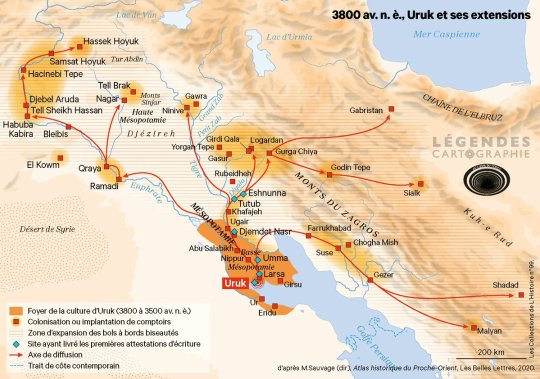
The expansion of Uruk, 3800 BC.
by LegendesCarto
92 notes
·
View notes
Text
The Sumerian Seven: The Top-Ranking Gods in the Sumerian Pantheon | Ancient Origins
https://www.ancient-origins.net/human-origins-religions/sumerian-seven-top-ranking-gods-sumerian-pantheon-007787

View On WordPress
#4th millennium BC#Akkadian#An#Ana#Anthropomorphic#Anu#Anutu#cuneiform#Ea#Enki#Enlil#Euphrates River#Inanna#Iraq#Ishtar#Ki#Mesopotamia#Nanna#Ninhursag#Ninlil#Ninurta#polytheism#Sumer#Sumerian Pantheon#Tigris River#Ur#Utu#Ziusudra
2 notes
·
View notes
Text


2,500-Year-Old Greek-Illyrian Helmet Discovered in Croatia
Archaeologists discovered a Greek-Illyrian helmet dating 2,500 years in very good condition on Croatia’s Pelješac peninsula.
The same team that found the Greek-Ilyrian helmet in 2020, in the same place, has found the next helmet, which according to the first analysis is older than the one found earlier.
The previous example most likely belonged to a member of the warrior elite who was interred there because it was discovered in a grave with pieces of iron weapons.
Archaeologists think the recently discovered helmet may have been a votive deposit because it was discovered in a dry stone-walled addition to a grave.
Greco-Illyrian type helmets originated in Peloponnese, Ancient Greece, where it likely evolved from the Kegelhelm (or Kegel type) of the Archaic Period.
The Greek-Illyrian helmet is extremely rare
Both of the helmets found are of different types and dates: The helmet discovered in 2020 was of a type commonly used in Greece and Illyria in the 4th century BC. It was an open-faced helmet with a rectangular cross-section for the face and decorative edges.
The newly found helmet is thought to date from the 6th century BC and is extremely rare. Finding two different Greek-Illyrian helmets at one site is unprecedented.
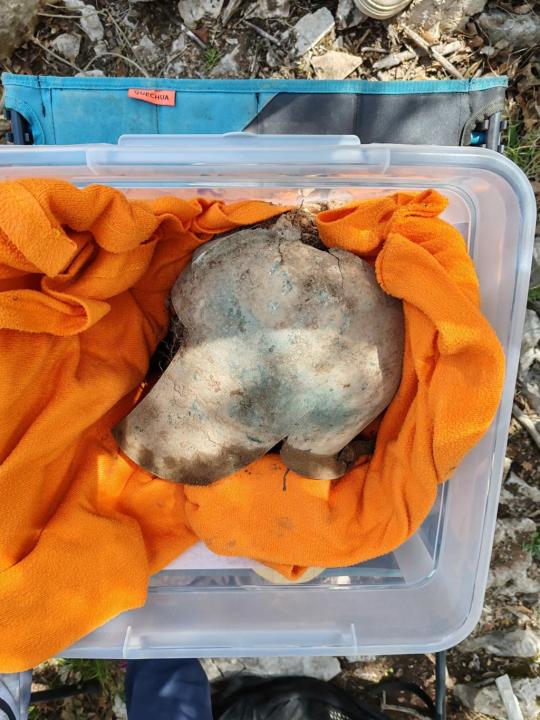

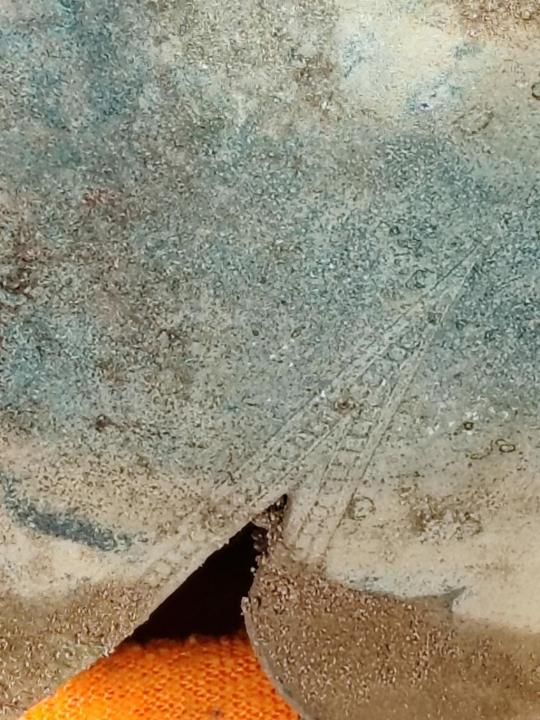
This find, along with a wealth of clothing, jewelry, and burial artifacts unearthed since the excavations began, greatly expands our knowledge of the funeral practices of Illyrian communities in the latter half of the first millennium BC.
The Illyrians were a group of Indo-European-speaking people who inhabited the western Balkan Peninsula in ancient times. They constituted one of the three main Paleo-Balkan populations, along with the Thracians and Greeks.
“What is very interesting is that two different types appear here in the same place, which speaks of a continuity of power of the respective community. These helmets have always been a symbol of some kind of status and power,” said Professor Hrvoje Potrebica, from the Department of Archeology of the Faculty of Philosophy in Zagreb.
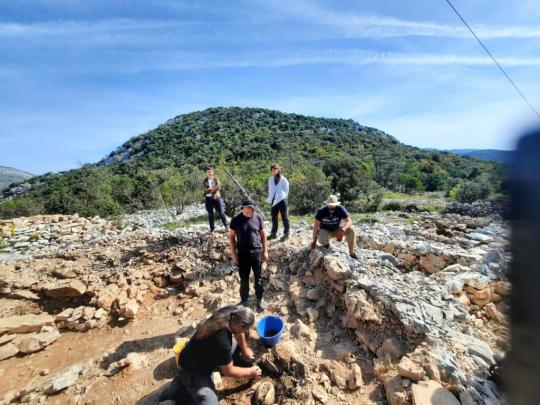
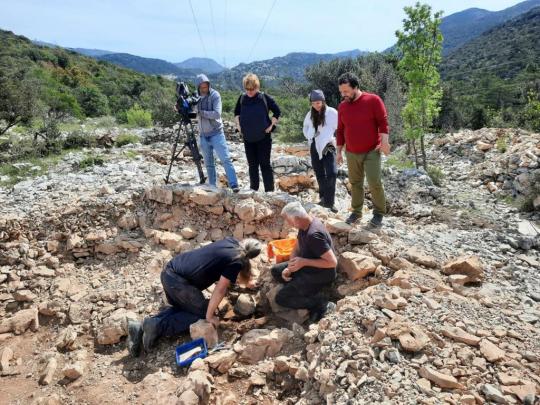
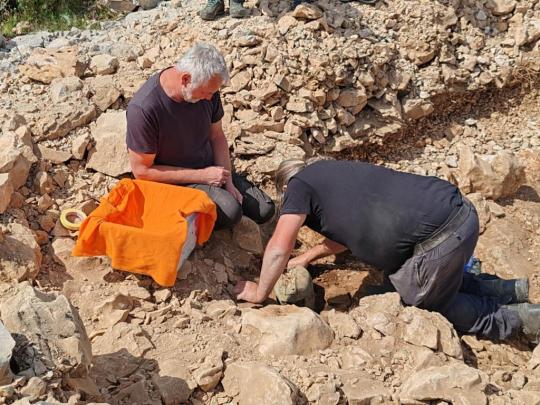
Speaking on the discovery, a representative from the Dubrovnik Museum said: “Along with numerous finds of jewelry, costumes and grave goods, this find of a helmet contributes in many ways to the knowledge of funeral rituals of Illyrian communities in the second half of the last millennium BC, and it ranks the area of Pelješac as one of the most important archaeological zones of the eastern Adriatic coast.”
Recently, archaeologists in Southern Italy have unearthed several significant artifacts, including two helmets, fragments of weapons and armor, and pottery shards, at an archaeological site in the ancient Greek city of Velia.
By Tasos Kokkinidis.
#2500-Year-Old Greek-Illyrian Helmet Discovered in Croatia#ancient Greek city of Velia#ancient artifacts#archeology#archeolgst#history#history news#ancient history#ancient culture#ancient civilizations#greek history#greek art
149 notes
·
View notes
Text
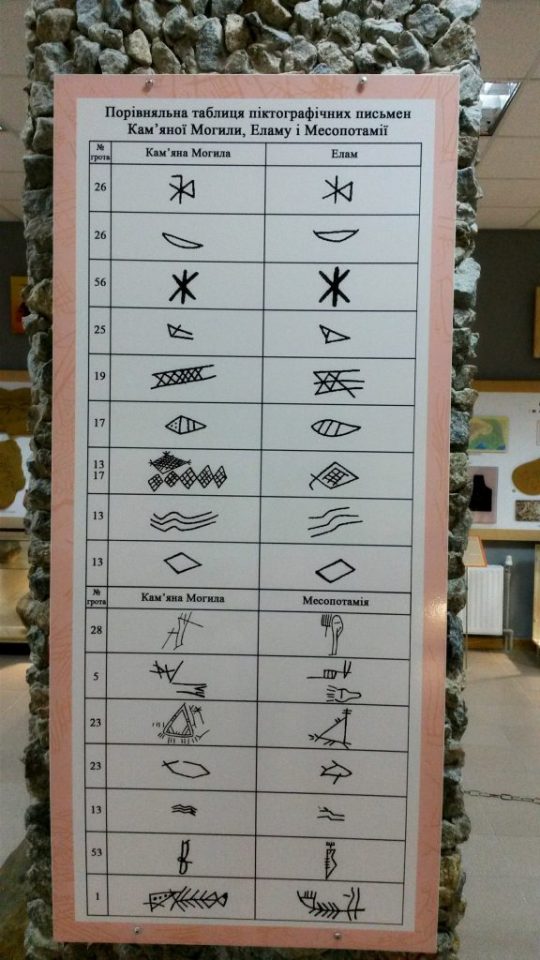


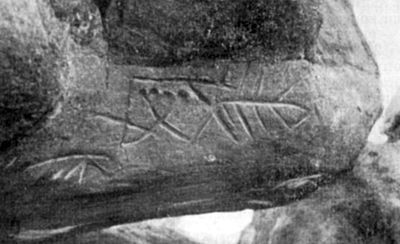
Kamyana Mohyla is believed to contain the first writing in the world.
According to the Ukrainian scientist I. M. Rassokha, most of the inscriptions of Kamyana Mohyla have direct parallels with the ancient Ogamic inscriptions of the British Isles, Germanic "coniferous" runes, ancient Slavic "strokes and cuts", etc., that is, it can be a monument of the most ancient sacred writing of the era of Indo-European unity, namely the Seredniy Stog culture of the 4th millennium BC.
The famous linguist N. Marr proved that the Ukrainian verb "to search" (шукати - shukaty) comes from the Sumerian "shu" - "hand". The Kyivan researcher S. Paukov believes that the Ukrainian words "shana" (honour) and "shanuvaty" (to pay respect) also came from the Sumerian "Shu-Nun" (which is believed to mean "the hand of the queen).
The Sumerologist A.G. Kyfishyn studied the inscriptions of the Kamyana Mohyla (VII-III millennia BC) for a long time and found many parallels with inscriptions on clay tablets of the civilizations of Elam and Mesopotamia (Sumeria): This "writing", as he believes, was invented by the "proto-Sumerians" who lived in "Ukrainian Aratta" as early as the 12th millennium BC, and from there this ancient ethnic group apparently moved to Mesopotamia after the flooding of the Northern Black Sea, which, according to G.A. Kyfishyn, reflected in the biblical message about the World Flood.
Kamyana Mohyla has been occupied by russians since 2022.
122 notes
·
View notes
Text
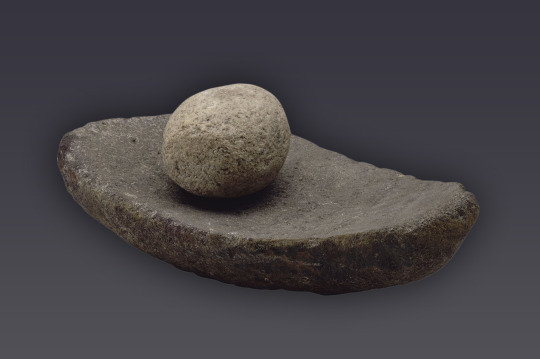
Millstone, France, 4th-2nd millennium BC
from The National Archaeological Museum, France
113 notes
·
View notes
Text
The Sumerians were the first known people to settle in Mesopotamia over 7,000 years ago. Located in the southernmost part of Mesopotamia between the Tigris and Euphrates rivers (modern day Iraq), Sumer was often called the cradle of civilization. By the 4th millennium BC, it had established an advanced system writing, spectacular arts and architecture, astronomy and mathematics. The Akkadians would follow the Sumerians, borrowing from their culture, producing a new language of their own, and creating the world’s first empire.
34 notes
·
View notes
Text
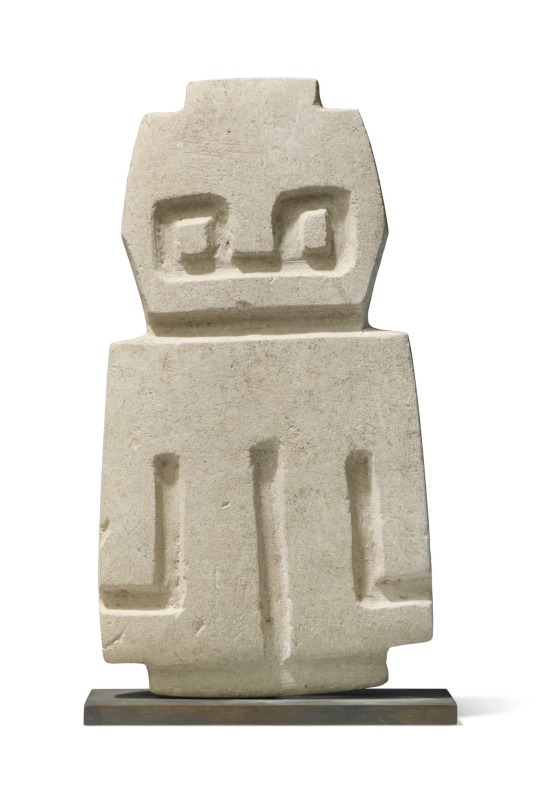
Ancient stone steles from Ecuador are the oldest stone sculptures known to exist in the New World, and are probably idols that were used in ritual contexts. They date as far as back as the 4th millennium BC and while each stele is unique, there are some common characteristics. They are all made from the same pearly grey sandstone and are also fairly uniform in their ‘blockish’ form. The steles have four common themes: the shaman with stylised owl-like facial features, the serpent/arrow, the sun chart and the star chart or ‘cosmogram’. A consistent aspect of the shaman stele is the formation of the eyes, which is always carved like the capital letter ‘B’ turned on its side. It was believed that the owl was a mystical creature of the night that had the ability to fly to other worlds and was therefore very closely associated with the shaman.
VALDIVIA STONE FIGURE
CIRCA 2300-2000 B.C.
Christie’s
24 notes
·
View notes
Text
Capitalism: "We're introducing The Round"
Someone: "It's just a wheel. It's been around since the 4th millennium BC
Capitalism: "But it's now The Round™ and you will pay thousands for the improvement"
Someone: "What improvement?!"
Capitalism: "It is officially even rounder and now provided in a variety of copyrighted patterns and finishes that have nothing to do with function"
Capitalism: "Also, it no longer works without a wifi connection, and a monthly subscription"
15 notes
·
View notes
Text
also given that in the tv show’s timeline, ra is overthrown and the stargate is buried ca. 3000 BC, it’s quite impressive that the goa’uld apparently managed to find among various bronze age peoples 9th century mongols, 4th century goths, 1st century mesoamericans, 1st millennium BC etruscans, early medieval christians (!), and 13th century Norse to transplant to the various planets they colonized
39 notes
·
View notes
Text

Greco-Buddhist Art: A Fusion of Eastern and Hellenistic Traditions
BY DIMOSTHENIS VASILOUDIS
Greco-Buddhist art stands as a remarkable testament to the intermingling of classical Greek culture with Buddhism, marking a significant chapter in the annals of art history. This unique artistic tradition, known as Greco-Buddhism, emerged from a fascinating blend of Eastern and Western cultural elements, flourishing over a span of nearly a millennium. From the conquests of Alexander the Great in the 4th century BCE to the Islamic conquests of the 7th century CE, Greco-Buddhist art developed across Central Asia, showcasing the depth and breadth of cultural syncretism.
The inception of Greco-Buddhist art can be traced back to the Hellenistic Greco-Bactrian kingdom, established in what is now Afghanistan between 250 BC and 130 BC. The establishment of the Indo-Greek kingdom from 180 BC to 10 BC further accelerated the spread of Hellenistic culture into the Indian subcontinent during this time period. It was in the Gandhara region of today's northern Pakistan that the melding of Greek and Buddhist cultures reached its zenith, under the auspices of the Indo-Greeks and later the Kushans. Gandhara became the cradle of Greco-Buddhist art, from which its influence radiated into India, impacting the art of Mathura and subsequently the Hindu art of the Gupta empire. This latter influence extended throughout Southeast Asia, while Greco-Buddhist art also made its way northward, leaving its mark on the Tarim Basin and ultimately influencing the arts of China, Korea, and Japan.
Characterized by the strong idealistic realism and sensuous depiction inherent to Hellenistic art, Greco-Buddhist art is renowned for introducing the first human representations of the Buddha. This pivotal development not only helped define the artistic and sculptural canon of Buddhist art across Asia but also served as a bridge between the aesthetic ideals of the East and the West. The portrayal of the Buddha in human form, imbued with the grace and precision of Greek sculpture, lent a new dimension to Buddhist iconography, enriching its symbolic and emotional depth. ...
7 notes
·
View notes
Text

Yoke
Olmec
10th–4th century BC
Central Mexican artists in the first millennium B.C. created stone objects in the form of yuguitos (small yokes, in Spanish) that likely served as parts of ceremonial belt assemblages. One of the finest known examples, this yuguito contains a human portrait in relief on one side. The face would have looked out at the viewers as the u-shaped stone was mounted over a thick cloth or leather waist belt, leaving the plain side towards the body of the wearer.
source
12 notes
·
View notes
Photo

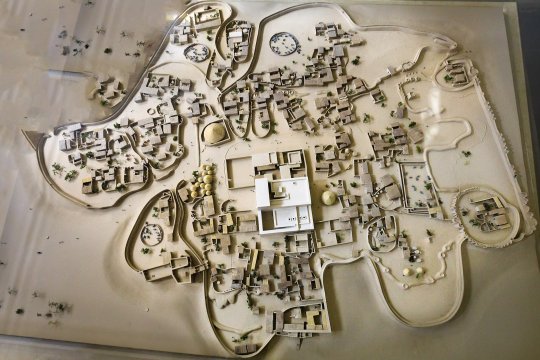
When is the first evidence of an African empire?
I will have to go with Kerma, below I’ll explain why .
The general political situation in the Neolithic Southern Nile Valley (left), pre-Kerma around c. 4th millennium BC (centre), and a Medjay warrior depicted on a bucranium (cattle skull) from Mostagedda, Middle Egypt, (right), illustrating the use of Hieroglyphs among the southern populations living among the Egyptians
See where Kerma is in the purple ? it would take all those other polities creating a large Empire to be known as Kush.
So if by Empire we are talking about a state gobbling up multiple states, many may think Egypt because the land area was large, but Kerma at it’s height took over all the surrounding polities under a unified front, I guess one could argue the same for the early unification of the upper and Lower Egypt, but these were multiple entities from as far away as Punt even.


The standing remains of a c. 4000 year old monument. The Western Deffufa, a massive mud brick temple in the center of Kerma, capital of the first Kingdom of Kush.
The rise of Kerma (c. 2500 BC) sees the absorption of these tribes into a strong centralised state, know as Kush, which ended up rivalling Egypt itself. This period sees some of the first monumental construction activities in Sudan, organised labour, advanced metallurgy, cross-continental trade networks and the earliest use of Egyptian hieroglyphs as well as being embroiled in violent conflict with their northern neighbour, annexing lower Nubia and raiding as far north as Thebes. A thousand years after its establishment, the Kingdom of Kerma was conquered by the New Kingdom. 500 Years of occupation blurred the lines between Kush and Egypt, as the material culture of the two countries became nearly indistinguishable.

Aerial view of a historic reconstruction of the central district of the Royal City of Kerma, somewhere around c. 2050 - 1750 BC, showing the Western Deffufa, a massive mud-brick religious monument, still standing today at 18 meters in height , surrounded by elite residential area's. This central area was walled with massive earthen ramparts with bastions. A large necropolis, shrines, palaces and agricultural villages extending north and south towards the fertile plain of the Nile surrounded this district.
The rise of Kerma (c. 2500 BC) sees the absorption of these tribes into a strong centralised state, know as Kush, which ended up rivalling Egypt itself. This period sees some of the first monumental construction activities in Sudan, organised labour, advanced metallurgy, cross-continental trade networks and the earliest use of Egyptian hieroglyphs as well as being embroiled in violent conflict with their northern neighbour, annexing lower Nubia and raiding as far north as Thebes. A thousand years after its establishment, the Kingdom of Kerma was conquered by the New Kingdom. 500 Years of occupation blurred the lines between Kush and Egypt, as the material culture of the two countries became nearly indistinguishable.

The following is important as to why I think Kerma was the first Empire.
The El Kab inscription
The tomb belonged to Sobeknakht, a Governor of El Kab, an important provincial capital during the latter part of the 17th Dynasty (about 1575-1550BC).
The inscription describes a ferocious invasion of Egypt by armies from Kush and its allies from the south, including the land of Punt, on the southern coast of the Red Sea. It says that vast territories were affected and describes Sobeknakht’s heroic role in organising a counter-attack.
The text takes the form of an address to the living by Sobeknakht: “Listen you, who are alive upon earth . . . Kush came . . . aroused along his length, he having stirred up the tribes of Wawat . . . the land of Punt and the Medjaw. . .” It describes the decisive role played by “the might of the great one, Nekhbet”, the vulture-goddess of El Kab, as “strong of heart against the Nubians, who were burnt through fire”, while the “chief of the nomads fell through the blast of her flame”.
The discovery explains why Egyptian treasures, including statues, stelae and an elegant alabaster vessel found in the royal tomb at Kerma, were buried in Kushite tombs: they were war trophies
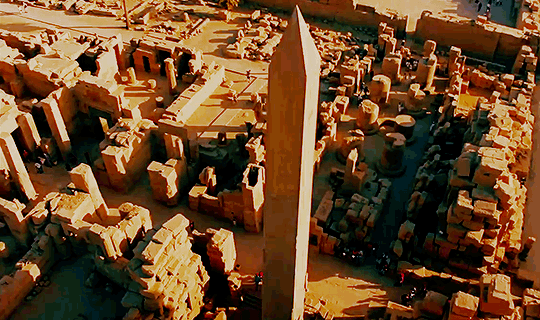
#ta seti#nubi#kemetic dreams#north africans#north africa#northeast africa#punt#kerma#egypt#ta meri#kemet
40 notes
·
View notes
Text
Babylonian Astrology: How Mesopotamian Priests Influenced Your Horoscope | Ancient Origins
Just remember, Mesopotamia is the "cradle of civilization." Pretty much meaning that Mesopotamia came up with astrology. (Don't quote us on this. We're making an educated assumption about this one, friends.)
https://www.ancient-origins.net/history-ancient-traditions/babylonian-astrology-0010806

View On WordPress
#15K BC#17th century#18 Constellations#2nd Millennium BC#3rd millennium BC#400 BC#410 AD#4th century#4th century BC#750 BC#Akkadian#Alexander the Great#Anu#Assyrian#Astrolabe#Astrology#Augustus Caesar#Babylon#Babylonian#Capricorn#Central America#China#Copernicus#Ea#Earth#Enlil#Fire#Firmicus#France#Greeks
5 notes
·
View notes
Text
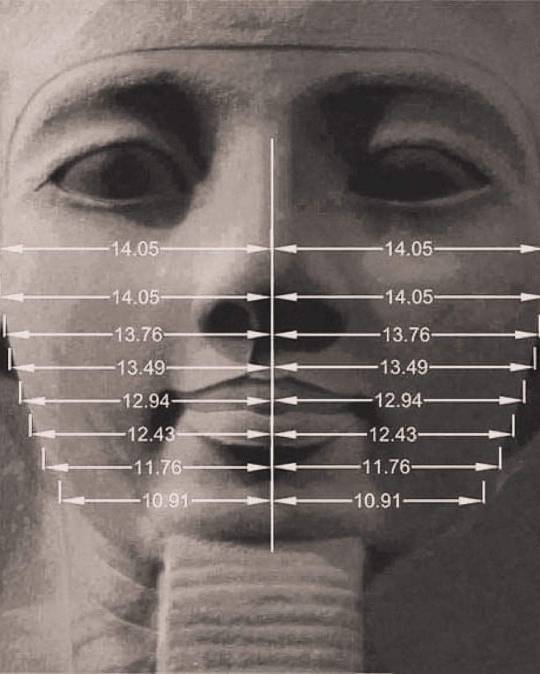
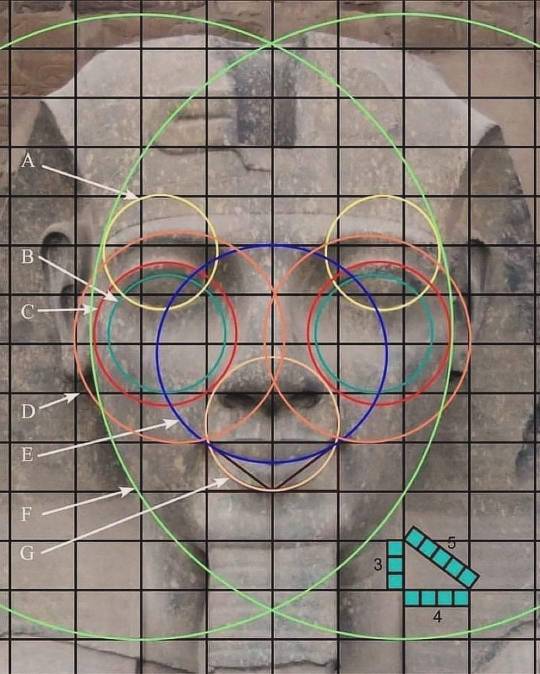

Ancient Egyptian art refers to art produced in ancient Egypt between the 6th millennium BC and the 4th century AD, spanning from Prehistoric Egypt until the Christianization of Roman Egypt. It includes paintings, sculptures, drawings on papyrus, faience, jewelry, ivories, architecture, and other art media.
3 notes
·
View notes
Text

Neolithic Aegean Marble Idol, 5th—4th millennium BC
2 notes
·
View notes
Text
Archaeologists have unearthed a 14.5 km (9mi) oasis fortification dating back to 2250 BC in Khaybar, Saudi Arabia. This fortress standing since the 4th millennium BC tells of the vibrant history of northwest Arabia, where lush oases thrived amidst arid expanses, shaping civilizations from the Paleolithic to the present.
The mysteries of Khaybar Oasis, one of Saudi Arabia's largest walled oases, once guarded precious water resources in the desert and nomad pastoralists strategically settled in this ancient haven, marking their cultural space in the heart of the North Arabian Desert.
This ground-breaking study published in the Journal of Archaeological Science, reveals the fascinating blend of nomad pastoralists, walled oases, and the monumental fortifications that have stood the test of time, shaping the rich tapestry of human habitation in pre-Islamic northwest Arabia. Principio del formulario
26 notes
·
View notes